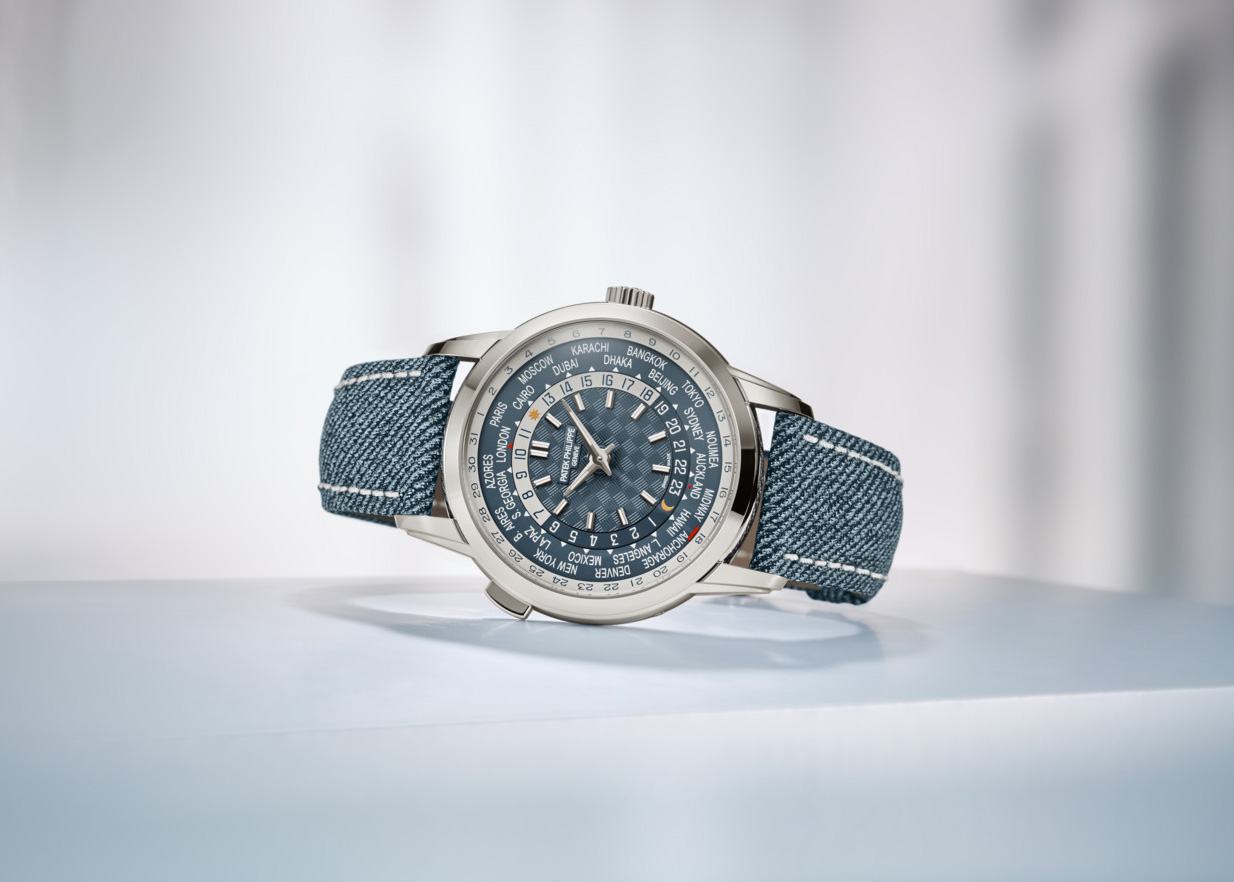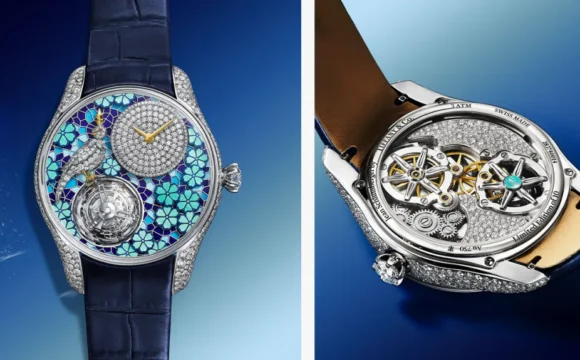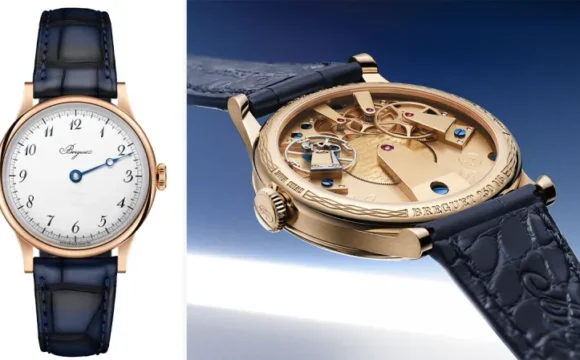นาฬิการุ่น 5330 เปิดตัวรุ่นลิมิตเต็ท เอดิชันครั้งแรกในงานนิทรรศการอันยิ่งใหญ่ของปาเต็ก ฟิลลิปป์ “Watch Art" ซึ่งจัดขึ้นที่กรุงโตเกียวเดือนมิถุนายน ปี 2023 โดยปัจจุบันนี้ได้เข้ามารวมอยู่ในคอลเล็กชันปกติของบริษัท นาฬิกาเวิลด์ไทม์รุ่นใหม่มีความโดดเด่นด้วยสิทธิบัตรโลกครั้งแรกของการแสดงวันที่ที่เป็นเวลาท้องถิ่น นั่น หมายความว่าเป็นการแสดงเวลาของโซนเวลาที่เลือกที่ตำแหน่ง 12 นาฬิกาบนดิสก์แสดงประเทศ โดยมีการ แสดงผลด้วยเข็มจากศูนย์กลางหน้าปัด คาลิเบอร์ 240 HU C กลไกไขลานอัตโนมัติใหม่ พร้อมด้วยนวัตกรรมของ ระบบดิฟเฟอเรนเชียล แสดงวันที่ที่วงรอบหน้าปัดด้วยเข็มนาฬิกาจากศูนย์กลางหน้าปัดที่ทำจากกระจกใส ปลาย เข็มรูปทรงค้อนสีแดง ตัวเรือนทองคำขาวสะท้อนความสง่างดงามร่วมกับหน้าปัดสีน้ำเงิน-เทาโอพะลีน กลาง หน้าปัดตกแต่งด้วยลวดลาย “carbon" วิวัฒนาการใหม่ด้านเทคนิคของนาฬิกาเวิลด์ไทม์ปาเต็ก ฟิลลิปป์ใหม่นี้ เสริมสร้างทางเลือกให้กับนาฬิกาสำหรับการเดินทางที่บริษัทสร้างสรรค์และนำเสนอ
เริ่มต้นในช่วงทศวรรษที่ 1930 อันเป็นยุคแห่งการเดินทางข้ามมหาสมุทรแอตแลนติกด้วยเครื่องบิน โดยการคิดค้น สร้างสรรค์จากหลุยส์ คอตติเยร์ ช่างผู้เชี่ยวชาญในการผลิตนาฬิกาแห่งเจนีวา ตั้งแต่นั้นมานาฬิกาเวิลด์ไทม์ปาเต็ก ฟิลลิปป์ที่มีชื่อเสียงได้นำเสนอการทำงานด้านเทคนิคที่มีประสิทธิภาพสูงอย่างต่อเนื่อง จากต้นปีทศวรรษที่ 1950 เป็น ต้นมาฟังก์ชั่นการทำงานนี้ช่วยให้สามารถอ่านผลของเวลา 24 ไทม์โซนได้พร้อมกันและถูกต้องถาวร ด้วยดิสก์ที่ เคลื่อนที่ 2 ชิ้น (ดิสก์แสดงชื่อเมือง และดิสก์แสดงเวลา 24 ชั่วโมง) ในขณะเดียวกันก็ยังสามารถแสดงเวลาท้องถิ่น (สำหรับเวลาของไทม์โซนที่เลือกที่ตำแหน่ง 12 นาฬิกา) ด้วยเข็มชั่วโมงและเข็มนาทีจากศูนย์กลางหน้าปัด ระบบอัน ชาญฉลาดนี้ได้รังสรรค์ไว้ร่วมกับหน้าปัดที่มักจะตกแต่งด้วยรูปแผนที่สีสดใส จากเทคนิคการเคลือบลงยาอินาเมลแบบ กรองด์ เฟอ ครัวซอนเน หรือการสลักลวดลายด้วยมือแบบกิโยเช่ ส่งผลให้กลไกความซับซ้อนนี้เป็นหนึ่งในโมเดลของ ปาเต็ก ฟิลลิปป์ซึ่งเป็นที่รู้จักมากที่สุดและยังเป็นหนึ่งในโมเดลที่ผู้ชื่นชอบกลไกการทำงานที่เป็นเลิศต้องการมากที่สุด
ดินแดนแห่งการสร้างสรรค์
ในปี 1999 ปาเต็ก ฟิลลิปป์ได้ประกาศถึงการพัฒนาสำคัญของฟังก์ชั่นการทำงานเวิลด์ไทม์ พร้อมด้วยกลไกที่ได้รับ สิทธิบัตรอันเป็นเลิศ เมื่อเจ้าของนาฬิกาเปลี่ยนโซนเวลา การกดที่ปุ่มกดหนึ่งครั้งเพียงพอสำหรับการปรับตั้งการแสดง ผลทั้งหมดด้วยกันในขั้นตอนเดียว (ดิสก์แสดงเมือง ดิสก์แสดงเวลา 24 ชั่วโมง และเข็มบอกเวลาชั่วโมงจากศูนย์กลาง) โดยที่ไม่มีผลกระทบต่ออัตราความเที่ยงตรงของนาทีและวินาที บริษัทได้นำเสนอนวัตกรรมนี้ในปี 2000 พร้อมกับการ เปิดตัวนาฬิการุ่น 5110 โดยเมื่อไม่นานมานี้วิศวกรของปาเต็ก ฟิลลิปป์ได้ผนวกกลไกเวิลด์ไทม์เข้ากับกลไกความ ซับซ้อนอื่น 2 ประเภทที่เป็นเอกลักษณ์เฉพาะของบริษัท โดยในปี 2016 บริษัทได้เปิดตัวนาฬิกาเวิลด์ไทม์ โครโนกราฟ รุ่น 5930 ติดตั้งด้วยคาลิเบอร์ CH 28-520 HU กลไกไขลานอัตโนมัติ จากนั้นในงานแสดงนิทรรศการอันยิ่งใหญ่ที่กรุง นิวยอร์คปี 2017 ปาเต็ก ฟิลลิปป์ได้นำเสนอนาฬิกาเวิลด์ไทม์ มินิท รีพีทเตอร์ รุ่น 5532 เรือนแรกที่มีกลไกตีให้เสียง เวลาท้องถิ่นเสมอ นาฬิการุ่น 5532 ติดตั้งด้วยคาลิเบอร์ R 27 HU กลไกไขลานอัตโนมัติ ซึ่งเป็นรุ่นลิมิตเต็ท เอดิชันที่ ปาเต็ก ฟิลลิปป์ผลิตออกมาเพียงแค่ 10 เรือน นาฬิกาโมเดลนี้ได้รวมอยู่ในคอลเล็กชันทั่วไปเมื่อปี 2018
การผนวกกันของฟังก์ชั่นการทำงานที่มีประโยชน์ในชีวิตประจำวัน
ครั้งนี้บริษัทได้สร้างประวัติศาสตร์ใหม่ให้กับนาฬิกาเวิลด์ไทม์ปาเต็ก ฟิลลิปป์ ด้วยการนำเสนอการแสดงผลวันที่เป็น ครั้งแรก ฟังก์ชั่นการทำงานใหม่นี้ค่อนข้างมีความท้าทายด้านเทคนิคเป็นอย่างยิ่ง นาฬิกาเวิลด์ไทม์อื่นๆ มีการแสดงผล ของวันที่ตามผู้เดินทางเมื่อมีการเปลี่ยนโซนเวลา การปรับตั้งโซนเวลาและการปรับตั้งวันที่จะแยกออกจากกัน อย่างไร ก็ตามปาเต็ก ฟิลลิปป์ตั้งใจและมุ่งมั่นที่จะสร้างประสบการณ์ให้กับผู้สวมใส่นาฬิกาเพื่อให้ใช้งานจริงได้สะดวกสบาย ที่สุด วิศวกรจึงได้สร้างสรรค์ให้กลไกแสดงวันที่ของเวลาท้องถิ่น (การเลือกโซนเวลาที่ตำแหน่ง 12 นาฬิกา และการ แสดงผลด้วยเข็มนาฬิกาที่ตำแหน่งศูนย์กลาง) โดยไม่ต้องมีการปรับตั้ง ดังนั้นฟังก์ชั่นการทำงานอันท้าทายดังกล่าวจะ แสดงผลของวันที่ซึ่งปรับตั้งโดยอัตโนมัติใน 2 สถานการณ์เมื่อมีการเปลี่ยนแปลง ได้แก่ เมื่อผ่านเวลาเที่ยงคืน โดยที่ วันที่จะเดินไปข้างหน้า 1 วัน และ เมื่อข้ามเส้นแบ่งเขตวันสากล (กลางมหาสมุทรแปซิฟิค) จากฝั่งตะวันตกไปฝั่ง ตะวันออก ซึ่งวันที่จะย้อนกลับไป 1 วัน ดังเช่นเรื่องที่รู้จักกันดีในประเด็นการลืมของฟิลิส ฟ็อกซ์ ซึ่งจูลน์ เวิร์น ได้ เขียนไว้ในหนังสือ “Around the World in Eighty Days" (เขาเชื่อว่าเขาได้สูญเสียการท้าพนันไปด้วยเวลา 1 วัน ซึ่ง ความผิดพลาดนี้สามารถหลีกเลี่ยงได้หากใส่นาฬิการุ่น 5330G-001 ใหม่) ครั้งนี้นาฬิกาเวิลด์ไทม์ มินิท รีพีทเตอร์รุ่น 5531 ที่รังสรรค์ขึ้นด้วยการผสมผสานกลไกความซับซ้อน 2 รายการในกลไกการทำงานเดียวกัน ซึ่งนอกจะมีความยาก และท้าทายแล้ว ยังจะต้องให้กลไกทั้งสองทำงานตอบโต้กัน โดยให้ฟังก์ชั่นเวิลด์ไทม์ควบคุมการแสดงผลของวันที่ (เช่น เดียวกับการให้ฟังก์ชั่นเวิลด์ไทม์ควบคุมฟังก์ชั่นมินิท รีพีทเตอร์ของนาฬิการุ่น 5531) ดังนั้นกลไกของวันที่จะต้อง สามารถทำงานได้ในทิศทางใดทิศทางหนึ่ง ไม่ว่าจะเป็นการเคลื่อนที่ไปข้างหน้าหรือการเคลื่อนที่ถอยหลัง ระหว่างที่มี การเปลี่ยนวันที่ และยิ่งไปกว่านั้นจะต้องทำงานได้น่าเชื่อถือ โดยไม่เสี่ยงที่จะสร้างความเสียหายต่อกลไกการทำงาน
การคิดค้นสร้างสรรค์ระบบดิฟเฟอเรนเชียลที่ได้รับสิทธิบัตร
เพื่อให้เกิดฟังก์ชั่นการทำงานที่ใช้งานง่าย มีประโยชน์และเป็นเอกลักษณ์เฉพาะ บริษัทได้พัฒนากลไกทำงานใหม่ ได้แก่ คาลิเบอร์ 240 HU C อันมีพื้นฐานมาจากคาลิเบอร์ 240 HU กลไกไขลานอัตโนมัติ ขนาดบางเป็นพิเศษ ซึ่ง ติดตั้งอยู่ในนาฬิกาเวิลด์ไทม์ของปาเต็ก ฟิลลิปป์ สำหรับโมเดลที่ไม่ได้เพิ่มเติมฟังก์ชั่นการทำงานใดๆ มาตั้งแต่ปี 2000 ฟังก์ชั่นที่โดดเด่นแรกของนวัตกรรมกลไกการทำงานนี้ได้แก่โมดูลการแสดงวันที่ อันประกอบด้วยชิ้นส่วนถึง 70 ชิ้น ระบบการควบคุมดิฟเฟอเรนเชียลที่ได้รับสิทธิบัตรประกอบด้วยจักรเกียร์รูปแบบดาวจากศูนย์กลาง 2 ชิ้นที่ทำหน้าที่ ควบคุมการแสดงผลของเวลาท้องถิ่น เมื่อจักรรูปดาวที่อยู่ด้านนอก (ขนาดเส้นผ่าศูนย์กลางที่ใหญ่กว่า และฟัน 62 ซี่) หมุนตามเข็มนาฬิกา เข็มวันที่จะเดินไปข้างหน้าตามเข็มนาฬิกา 1 ร่อง ในขณะที่เมื่อจักรรูปดาวที่อยู่ด้านใน (ฟัน 31 ซี่) หมุนตามเข็มนาฬิกา เข็มวันที่จะเคลื่อนที่ทวนเข็มนาฬิกา 1 ร่อง เมื่อจักรรูปดาวทั้งคู่หมุนตามเข็มนาฬิกา (ซึ่งควร จะหมายถึงกลไกการทำงานจะเดินไปข้างหน้าและข้างหลังพร้อมกันด้วยเข็มแสดงวันที่) ระบบดิฟเฟอเรนเชียลจะ ทำงานให้เข็มนาฬิกาอยู่ในตำแหน่งเดิม ดังนั้นการกดปุ่มกดที่ตำแหน่ง 10 นาฬิกาแต่ละครั้งจะเป็นการปรับตั้งเวลาที ละ 1 ชั่วโมง ไม่ใช่แค่สำหรับดิสก์แสดงเมือง ดิสก์แสดงเวลา 24 ชั่วโมงและเข็มแสดงเวลาชั่วโมงที่ศูนย์กลาง แต่ยังรวม ไปถึงการแสดงวันที่ ที่เคลื่อนที่ในทิศทางทั้งไปข้างหน้าและถอยหลัง ระบบนี้ถึงแม้จะมีความซับซ้อนแต่ก็ง่ายในการใช้ งาน อันสะท้อนให้เห็นได้เป็นอย่างดีถึงแนวคิดที่สร้างสรรค์ของปาเต็ก ฟิลลิปป์ในการให้ความสำคัญกับผู้ใช้งานมา ก่อนเป็นอันดับแรก นอกจากกลไกการทำงานที่เพิ่มเติมนี้ คาลิเบอร์ 240 HU C ใหม่ ยังมีความหนาที่เพิ่มขึ้นจาก คาลิเบอร์ 240 HU เพียง 0.7 มิลลิเมตร (4.58 มิลลิเมตร จากเดิม 3.88 มิลลิเมตร) ส่งผลให้ตัวเรือนมีความบางและ หรูหรางดงาม

การแสดงผลที่อ่านได้ง่ายและมีเอกลักษณ์เฉพาะ
ฟังก์ชั่นการทำงานที่โดดเด่นอย่างที่สองของนาฬิกาเวิลด์ไทม์ รุ่น 5330G-001 ใหม่ ได้แก่ โหมดของการแสดงวันที่ ปาเต็ก ฟิลลิปป์เลือกใช้เข็มบอกเวลาจากศูนย์กลางปลายเข็มรูปทรงค้อนเคลือบสีแดง ซึ่งเคลื่อนที่ไปรอบๆ สเกลที่ สร้างสรรค์ด้วยการพิมพ์แบบ transfer จาก 1 ถึง 31 โดยที่สเกลจะอยู่บริเวณขอบวงนอกสีเงินซึ่งมีความลาดเอียงบน หน้าปัด และเพื่อหลีกเลี่ยงการรบกวนการอ่านข้อมูลอื่นจากเข็มนาฬิกาในขณะที่อยู่คงที่ จึงเป็นครั้งแรกของปาเต็ก ฟิลลิปป์ ที่นักวิศวกรได้รังสรรค์เข็มนาฬิกาทำจากกระจก
คุณลักษณะที่สะท้อนให้เห็นผ่านรูปลักษณ์
ดังเช่นนาฬิกาเวิลด์ไทม์ปาเต็ก ฟิลลิปป์รุ่นอื่นทั้งหมด นาฬิการุ่น 5330G-001 ใหม่โดดเด่นด้วยรูปลักษณ์ที่งดงามเป็น เลิศอย่างยิ่ง กลางหน้าปัดรูปแบบโอพะลีนเสริมความงดงามด้วยเฉดสีน้ำเงิน-เทา พร้อมลวดลาย “carbon" ที่สง่า งามช่วยให้ดูทันสมัย ดิสก์แสดงเวลา 24 ชั่วโมงแบ่งออกเป็นส่วนของช่วงกลางวัน และช่วงกลางคืน ซึ่งใช้รูปดวง อาทิตย์ชุบทองขนาดเล็กบนพื้นหลังสีเงินสำหรับบ่งบอกเวลาเที่ยงวัน และรูปดวงจันทร์ครึ่งซีกชุบทองบนพื้นหลังสีน้ำ เงิน-เทาสำหรับแสดงเวลาเที่ยงคืน บนดิสก์ชื่อเมืองมีจุดสีแดงระหว่างเมืองโอ๊คแลนด์และมิดเวย์ ที่แสดงถึงเส้นแบ่ง เขตวันสากล เข็มนาฬิการูปทรงดอร์ฟินเจียรไนเหลี่ยมและหลักบอกเวลารูปทรงบาตองเจียรไนเหลี่ยม ทำจาก ทองคำขาวเคลือบสารเรืองแสง ขนาดเส้นผ่าศูนย์กลางตัวเรือน 40 มิลลิเมตร เคียงคู่อยู่บนหูตัวเรือนโค้ง 2 ระดับที่ งดงามดึงดูดสายตาเป็นอย่างยิ่ง ฝาหลังกระจกแซฟไฟร์คริสตัลเผยให้เห็นโครงสร้างของคาลิเบอร์ 240 HU C กลไกไข ลานอัตโนมัติใหม่ ซึ่งทุกชิ้นส่วนได้รับการรังสรรค์ประดับตกแต่งอย่างประณีตละเอียด
สายนาฬิกาหนังลูกวัวสีน้ำเงินเทา สลักลวดลายนูนแบบเดนิม ตะเข็บเย็บด้วยมือสีขาว สะท้อนความงดงามของสี หน้าปัด พร้อมหัวเข็มขัดแบบบานพับทองคำขาว
ไทม์โซนและเส้นแบ่งเขตวันสากล
เป็นเวลานานมากแล้วที่ทุกประเทศหรือทุกเมืองแสดงเวลาท้องถิ่นของตัวเองโดยขึ้นอยู่กับเส้นลองติจูด ในขณะที่นัก เดินทางต้องปรับการแสดงผลบนนาฬิกาของตัวเองโดยตลอด แต่ในยุคแห่งการเติบโตที่รวดเร็วของการเดินทางและ การสื่อสารที่นำไปสู่ความต้องการในการรวมระบบเวลาเข้าด้วยกัน เมื่อปี 1884 ในงานประชุม International Meridian Conference ที่กรุงวอชิงตัน ได้มีการตัดสินใจแบ่งโลกออกเป็น 24 โซน ที่ทุกๆ 15 องศาลองติจูด (เวลา 1 ชั่วโมง) และให้ใช้จุดอ้างอิง (ลองติจูดศูนย์) เป็นเส้นเมริเดียนแรก ซึ่งนักเดินเรือได้ใช้แนวทางนี้แล้ว
จากระบบดังกล่าวโซนเวลาในโอ๊คแลนด์ (ประเทศนิวซีแลนด์) จึงมีเวลา 12 ชั่วโมงก่อนเวลามาตรฐานกรีนิช (UTC +12) ดังนั้นจึงเป็นประเทศแรกที่ข้ามผ่านวันต่อไป ในทางตรงกันข้ามโซนเวลาสำหรับส่วนมิดเวย์ (เกาะและพื้นที่ของ ประเทศสหรัฐอเมิรกาในแปซิฟิคเหนือ) เวลาจะช้ากว่ามาตรฐานกรีนิช 11 ชั่วโมง (UTC -11) จึงเป็นบริเวณสุดท้ายที่ จะข้ามผ่านวัน ตัวอย่างเช่น เมื่อเดินทางไปยังฝั่งตะวันตกจากบริเวณมิดเวย์ไปเมืองโอ๊คแลนด์ จำเป็นต้องเพิ่มวันไป ข้างหน้า 1 วัน และเมื่อเดินทางไปทางฝั่งตะวันออกจากเมืองโอ๊คแลนด์ไปยังบริเวณมิดเวย์ วันที่จะต้องย้อนกลับมา 1 วัน สำหรับเส้นแบ่งเขตวันสากลซึ่งอยู่ระหว่างเมืองโอ๊คแลนด์และมิดเวย์ (และยังไม่เป็นประเด็นในสนธิสัญญาใดๆ) จะ คดเคี้ยวไปมารอบๆ เส้นเมริเดียน 180 องศา บริเวณกลางมหาสมุทรแปซิฟิค ดังนั้นเกาะต่างๆ บริเวณนั้นเลือกโซนเวลา ของตนเองได้ตามที่ต้องการ
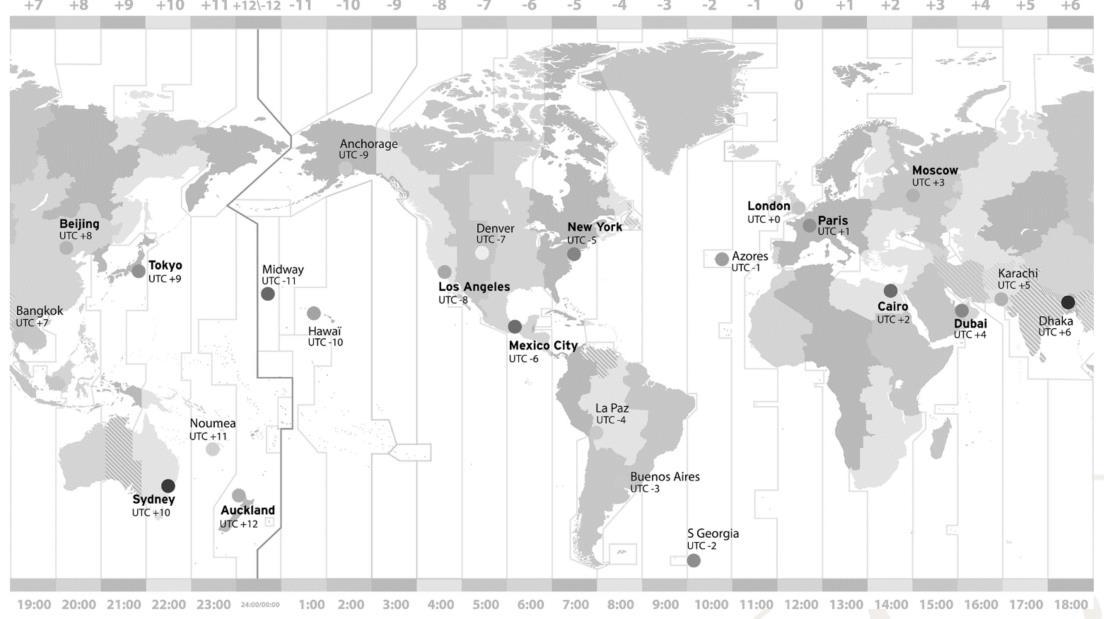
อย่างไรก็ตามระบบดิฟเฟอเรนเชียลนี้จะทำงานพิเศษได้อย่างหนึ่ง คือ ในระหว่างช่วงเวลา 11.00 นาฬิกา ถึงเวลา 12.00 นาฬิกาของกรุงลอนดอน คือ เวลา 24.00 นาฬิกา ถึง 01.00 นาฬิกา ที่บริเวณมิดเวย์ และระหว่างช่วงเวลา 23.00 นาฬิกา ถึงเวลา 24.00 นาฬิกาที่เมืองโอ๊คแลนด์ (ยกเว้นแต่ช่วงของเวลาออมแสง หรือ daylight saving) ดังนั้นทั่วโลกจะมีวันที่เดียวกันในเวลา 1 ชั่วโมงดังกล่าว อย่างไรก็ตามต้องยกย่องให้กับระบบดิฟเฟอเรนเชียลซึ่งได้รับ สิทธิบัตร ที่สามารถสร้างสรรค์ให้นาฬิกาเวิลด์ไทม์ รุ่น 5330G-001 ทำงานตามรูปแบบนี้ได้ โดยยังคงดำรงวันที่ไว้ อย่างคงที่แม้ว่าจะมีการเลือกไทม์โซนอื่นโดยการกดปุ่มกดที่ตำแหน่ง 10 นาฬิกา หากปราศจากระบบดิฟเฟอเรนเชียล ในช่วงเวลาที่วันที่เป็นเวลาของทุกไทม์โซน นั่นหมายถึงเวลาเที่ยงคืน หากเจ้าของนาฬิกาเดินทางข้ามเส้นแบ่งเขตวัน สากลซึ่งอยู่บริเวณเมืองโอ๊คแลนด์และบริเวณมิดเวย์ นาฬิกาจะส่งสัญญาณ 2 สัญญาณที่ขัดแย้งกันให้กับจักรรูปทรง ดาวเหมือนกัน คือให้วันที่เดินไปข้างหน้า 1 วัน และให้วันที่เคลื่อนย้อนไปข้างหลัง 1 วัน ซึ่งจะทำให้เกิดการปิดกั้น กลไกการทำงาน
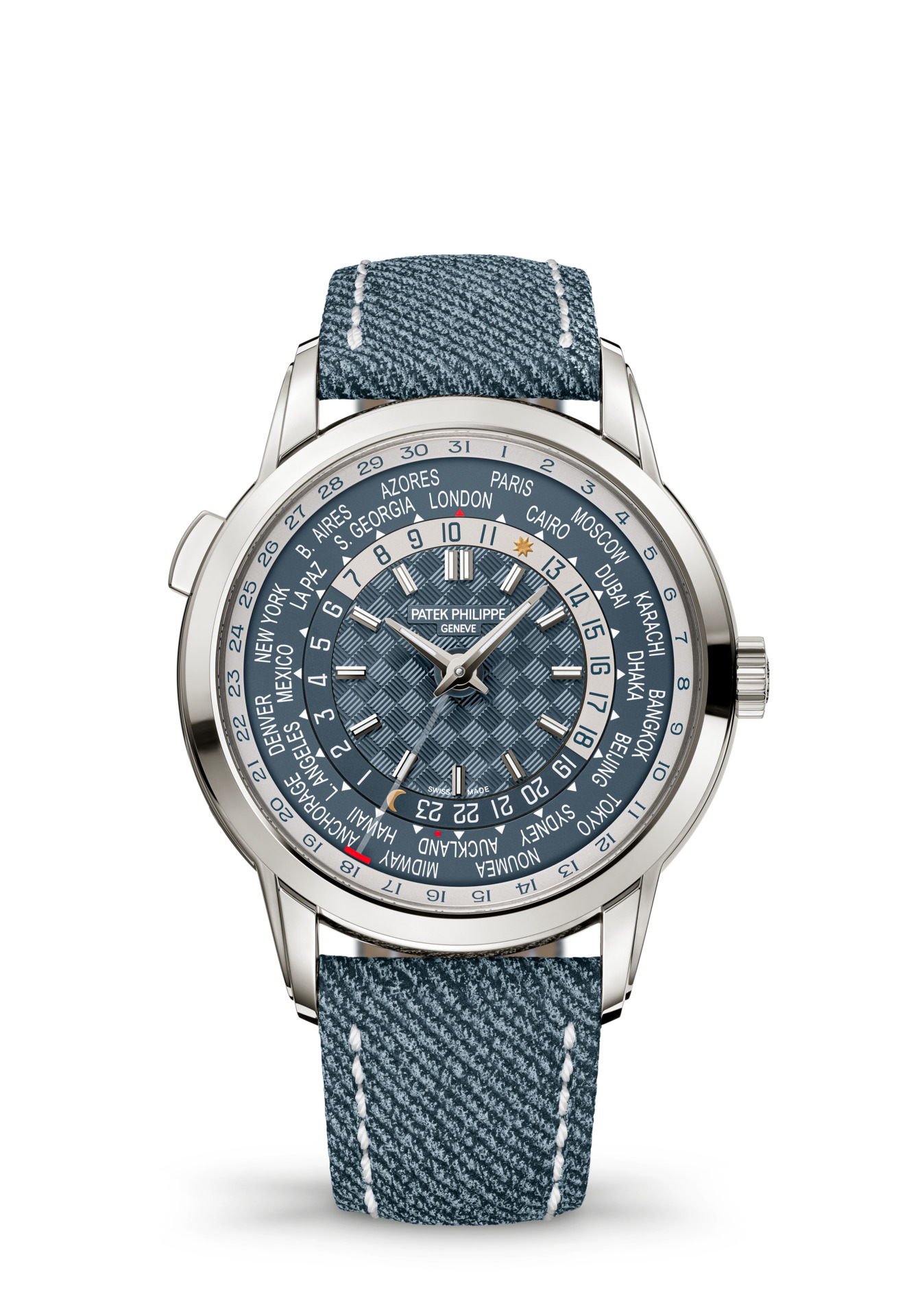
The new generation of the World Time watch, featuring a world first: a date display synchronized with local time
Launched as a limited edition at the Patek Philippe grand exhibition “Watch Art" held in Tokyo in June 2023, Reference 5330 now enters the manufacture’s regular collection. This new-generation World Time is distinguished by a patented world first: a date display synchronized with local time; that is, the time in the time zone selected at the 12 o’clock position on the city disk and indicated by the center hands. The new caliber 240 HU C self-winding movement, with an innovative differential system, indicates the date on the periphery of the dial by means of a center hand in transparent glass with a red hammer-head-style tip. The elegant white-gold case frames a dial in blue-gray opaline, its center adorned with a “carbon" motif. This new technical evolution in the Patek Philippe World Time watches now enriches the choice of travel watches proposed by the manufacture.
Introduced in the 1930s, the era of the first transatlantic flights, and based on an invention by the Genevan master watchmaker Louis Cottier, the renowned Patek Philippe World Time has been technically optimized continually ever since. From the early 1950s onwards this function has made it possible to read off the time simultaneously and permanently in the 24 time zones, by means of two mobile disks (a city disk and a 24-hour disk) while also benefiting from a local-time display (in a time zone selected at the 12 o’clock position) by center hour and minute hands. This ingenious system, combined with dial centers often adorned with colorful maps in Grand Feu cloisonné enamel or hand-guilloched decorations, has made this complication one of the most recognizable of Patek Philippe models –and one of the most sought after by devotees of splendid mechanisms.
Innovative territory
In 1999, Patek Philippe announced a major improvement in the functionality of the World Time with an exclusive patented mechanism whereby, when its owner changes time zones, a single pressure on a push-piece suffices to adjust all the displays together (city disk, 24-hour disk and center hour hand) in one-hour steps –without affecting the rate accuracy of the minutes and seconds. This innovation was introduced in the year 2000 with the launch of Reference 5110. More recently, the engineers have also paired the World Time with two of the manufacture’s other most emblematic complications. In 2016 they unveiled the World Time Chronograph Reference 5930, with a caliber CH 28-520 HU self-winding movement. In 2017, on the occasion of the Grand Exhibition in New York, Patek Philippe presented the first World Time minute repeater that always chimes the local time: Reference 5531, with a caliber R 27 HU self-winding movement, in a limited edition of ten watches. This model joined the regular collection in 2018.
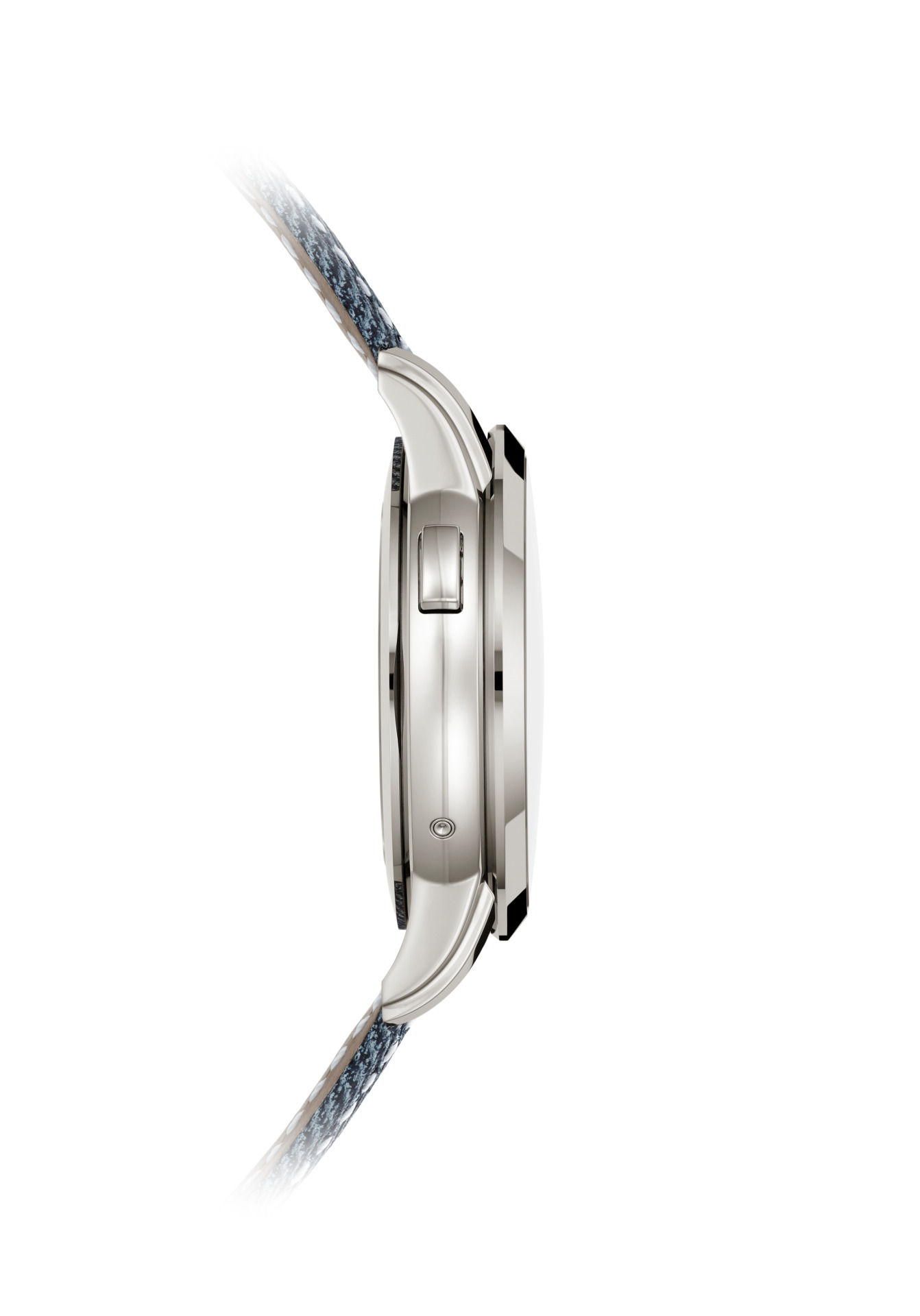
A new alliance of functions useful in everyday life
The manufacture is now marking a new milestone in the history of the Patek Philippe World Time watch by endowing it for the first time with a date display. While normally quite straightforward, here this function posed a real technical challenge. Other world-time watches equipped with a date indicator always oblige the traveler, when changing time zones, to adjust the time zone and the date independently. Patek Philippe, however, was intent on making the user experience as practical and comfortable as possible, and tasked its engineers with coupling the date display mechanically with the local time (the time zone selected at 12 o’clock and indicated by the center hands) with no need for correction. Meeting this challenge required, therefore, that the date adjust automatically in the two situations entailing a change: past midnight, when the date advances to that of the following day; and when crossing the International Date Line (in the middle of the Pacific Ocean) from west to east, where the date goes back by a day –as Phileas Fogg famously forgets in the Jules Verne novel “Around the World in Eighty Days". (He believes that he has lost his bet by a day, an error that he would have avoided had he been wearing the new Reference 5330G-001). Here, as in the World Time Minute Repeater Reference 5531, accommodating the two complications in the same movement was not the only difficulty: they had to be made to interact, with the World Time controlling the date display (just as it controls the minute repeater in Reference 5531). Therefore, the date mechanism had to be able to function in either direction, backwards or forwards, during a date change, and to do so reliably, with no risk of damage to the movement.
An innovative, patented differential
To provide this useful, exclusive and user-friendly function, the manufacture developed a new movement, caliber 240 HU C, based on the caliber 240 HU ultra-thin self-winding movement that has equipped the Patek Philippe World Time watches without additional functions since the year 2000. The first distinguishing feature of this innovative movement is its date-display module, which alone comprises 70 parts. A patented central differential system comprising two concentric star-type gear wheels manages the local-time date. When the outer star (of larger diameter and with 62 teeth) turns clockwise, the date hand advances clockwise by one notch. When the inner star (with 31 teeth) turns clockwise the date hand moves back counterclockwise by a notch. When the two stars turn clockwise together (which should imply simultaneously a forward and a backward movement of the date hand) the differential allows this hand to remain stationary. Each pressure on the pusher positioned at 10 o’clock therefore serves to adjust, in one-hour steps, not only the city disk, the 24-hour disk and the center hour hand, but henceforth where applicable –the date, in either direction. Complex and yet so easy to operate, this system perfectly illustrates Patek Philippe’s creative philosophy of putting the user first. Furthermore, despite its additional mechanism, the new caliber 240 HU C movement is barely 0.7 millimeters thicker than caliber 240 HU (4.58 mm instead of 3.88 mm) allowing it be housed in a slender, elegant case.
Original, legible displays
The second distinguishing feature of the new World Time Reference 5330G-001 is its date display mode. Patek Philippe opted for a center hand with a hammer-shaped tip in red lacquer that moves along a transfer-printed scale from 1 to 31 at the outer edge of the dial on a beveled, silvery flange that creates a beautiful sense of depth. To avoid this relatively static hand’s disturbing the legibility of the other information, the manufacture’s engineers conceived –for the first time at Patek Philippe – a transparent hand made of glass.
Character shows in its face
As with all Patek Philippe World Time watches, the new Reference 5330G-001 stands out by its refined and highly distinctive appearance. Its opaline dial center in an elegant shade of blue-gray is adorned with a carbon motif, adding a dynamic modern touch. The 24-hour disk is subdivided into day and night zones, identified respectively by a small gilt sun on a silvery background symbolizing noon and a gilt crescent moon on a blue-gray ground symbolizing midnight. On the city disk, a red dot between Auckland and Midway marks the International Date Line. Faceted dauphine-style hands and faceted applied baton-style hour markers, all in white gold with a white luminescent coating, indicate local time in the time zone selected at the 12 o’clock position. The fully polished white-gold case, 40 mm in diameter, catches the eye with its curved two-tier fluted lugs. Its sapphire-crystal back affords a private view of the architecture of the new caliber 240 HU C self-winding movement and the painstaking finishing touches lavished on its parts.
A calfskin strap embossed with a denim motif, in blue gray with white hand-stitching, echoes the color of the dial. It is secured by a fold-over clasp in white gold.
Time zones and the International Date Line
It was long the case that every country- if not every city –had its own local time, based more or less on the longitude, and travelers constantly had to adjust the indications on their watches. But the era of rapid growth in transport and communications brought with it the need to unify the time system. In 1884, the International Meridian Conference in Washington resulted in the decision to divide the planet into 24 time zones, each covering 15 degrees of longitude (one hour) and to take as reference point (longitude 0) the Greenwich meridian, which navigators were already using for that purpose.
According to this system, the time zone in which Auckland (New Zealand) is situated is 12 hours ahead of that of Greenwich (UTC + 12). It is therefore the first to pass to the following day. On the other hand, the time zone applying to Midway (an atoll and area of the United States in the North Pacific) is 11 hours behind Greenwich (UTC -11). Thus, it is the last to pass to the following day. In our example, when one is travelling westward from Midway to Auckland it is therefore necessary to advance the date by a day. And when one is travelling eastward from Auckland to Midway the date must move back by a day. The International Date Line, which is situated between the Auckland and Midway time zones (and has not been the subject of any international treaty) zigzags around the 180°meridian in the middle of the Pacific Ocean at the will of the different islands’ choices of time zone.
But this system is nevertheless particular in one respect. During the time segment from 11 a.m. to noon in London, it is between midnight and 1 a.m. in Midway and between 11 p.m. and midnight in Auckland (unless daylight saving is in force). The entire planet is therefore on the same date for one hour. Thanks to its patented differential system, the new World Time Reference 5330G-001 respects this case by keeping the date stationary even when another time zone is selected using the push-piece at 10 o’clock. Without this differential system, in the time segment where the date is identical in all the time zones, that is, at midnight, when its owner crossed the International Date Line located between Auckland and Midway the watch would send two contradictory signals to the same star-wheel, one to advance the date by a day, the other to subtract a day – which would block the movement.


